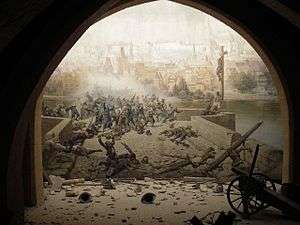Battle of Prague (1648)
| Battle of Prague | |||||||
|---|---|---|---|---|---|---|---|
Part of the Thirty Years' War
 | |||||||
| |||||||
| Belligerents | |||||||
|
|
| ||||||
| Commanders and leaders | |||||||
|
|
| ||||||
| Strength | |||||||
| cca 7500 soldiers (unconfirmed) plus 6000 reinforcements led by Charles X Gustav of Sweden | cca 2000 soldiers, plus local militia and Academic Legion | ||||||
| Casualties and losses | |||||||
| 500 dead, 700 wounded | 219 dead, 475 wounded | ||||||
The Battle of Prague, which occurred between 25 July and 1 November 1648 was the last action of the Thirty Years' War. General Hans Christoff von Königsmarck, commanding Sweden's flying column, entered the city, which was defended by the Governor Feldmarshall Rudolf von Colloredo, a veteran of the siege of Mantua and of the battle of Lutzen, where he served under Albrecht von Wallenstein. The Swedes captured Prague Castle on the western bank of the Vltava river and attempted to enter the Old Town on the eastern bank of the river, but were repulsed on the Charles Bridge by Colloredo's men. When a third Swedish army commanded by Prince Carl Gustaf came close to Prague, all three Swedish armies launched a number of attacks against the city. These attacks were resisted, largely thanks to the skill of the Feldmarshal and the energy of his troops. When in November Gustaf received a report about the signed Peace, he ordered his troops to leave.
Unable to enter the city, the Swedes settled for looting the Castle. Many of the treasures collected by Emperor Rudolf II (such as the Codex Gigas and Codex Argenteus) were taken to Sweden, whereof some can be found in Drottningholm Palace.
A monument erected during the 19th century on Colloredo's tomb in the Maltese Order Church in Prague remind his victory over the Swedish. Its German inscription reads thus:
HIER RUHT RUDOLF GRAF COLLOREDO K.K. FELDMARSCHALL UND MALTHESERORDER GROSSPRIOR Vertheididiger der Alt und Neusstad Prags gegen die Schweden Geb. Am 2 Nov. 1585 Gest. Am 27 Jan. 1657.
("Here lies Rudolf, count Colloredo, Imperial and Royal Feldmarshall and Grand Prior of the Order of Malta, defender of the Old and New Town of Prague against the Swedes. Born 2. Nov. 1585 Dead 27 Jan. 1657")
On Charles Bridge a 17th-century Latin inscription says:
SISTE VIATOR, SED LUBENS, AC VOLENS UBI SISTERE DEBUIT, SED COACTUS GOTHORUM, AC VANDALORUM FUROR
"Rest here, walker, and be happy: you can stop here willing, but unwilling were stopped the Goths (Swedes) and their Vandalic ferocity"
The battle was referenced in Sabaton's song "1648" in album Carolus Rex.
| Wikimedia Commons has media related to Battle of Prague (1648). |